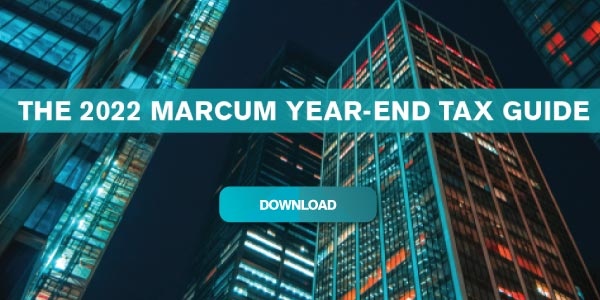2022 International Tax Highlights
This year produced some significant changes to existing foreign tax credit rules, as well as enhanced reporting requirements for entities treated as partnerships and subchapter S corporations. A corporate minimum tax was also imposed for large corporations. Following is a more detailed discussion of these provisions.
New Foreign Tax Credit Regulations
Current U.S. tax law allows taxpayers to claim a credit (or deduction) for foreign income taxes imposed by foreign countries or U.S. possessions. The foreign tax credits (FTC) may not exceed the foreign taxes paid multiplied by the fraction of the taxpayer’s income sourced outside the U.S. over the taxpayer’s total taxable income from all sources (outside and inside the U.S.).
On January 4, 2022, new final FTC regulations were released by the IRS and the U.S. Department of the Treasury providing guidance on whether a foreign tax is eligible for an FTC. These regulations substantially modify prior regulations and may restrict U.S. taxpayers from claiming FTCs with respect to certain foreign withholding and other taxes creditable in the past (under IRC § 901–905).
For creditability, a foreign income tax must satisfy the net gain requirement, which includes tests to establish realization, gross receipts and cost recovery. Under the net gain test, foreign income taxes were required to meet the following three requirements to be considered creditable:
- Realization Requirement: Imposed on certain realization events or pre-realization events.
- Gross Receipts Requirement: Imposed on the basis of gross receipts or a measure of deemed gross receipts that is not likely to exceed actual gross receipts.
- Cost Recovery: Allows the recovery of significant costs attributable to the gross receipts or a measure of significant costs that is likely to approximate actual costs. A gross basis tax may meet the cost recovery requirement if, in fact, there are no significant costs and expenses attributable to the gross receipts included in the taxable base.
The net gain requirement now incorporates an “attribution requirement” that must be satisfied. The attribution requirement subjects residents and nonresidents to different rules for foreign country taxation.
1. Resident’s Attribution Requirement:
- Requires the country’s transfer pricing rules to allocate income among related parties under the arm’s-length principals, and the allocation of income must not “take into account as a significant factor the location of customers, users, or any other destination-based criteria” (i.e., the net gain requirement).
2. Nonresident’s Attribution Requirement:
- Attribution of income and cost must be attributed under one of the following three principles:
- Activity-based: Foreign tax imposed on nonresidents’ activities must be limited to the gross receipts and costs attributed under “reasonable principles” to nonresidents’ activities within the foreign country imposing the tax. This includes the nonresident’s functions within the foreign country and assets and risks located in the country (e.g., IRC § 864).
- Under the final regulations, no FTC is allowed for foreign taxes that (1) consider the location of customers, users or similar destination-based criteria; (2) the location of a supplier; or (3) the location of a permanent establishment (“PE”) where there are activities by people other than the nonresident.
- Source–based: To satisfy the source rule, the foreign tax must be based on a sourcing rule that is “reasonably similar” to U.S. sourcing rules. For example, services income taxation must be based on where the services are performed (i.e., IRC § 861(a)(3)) and royalty income taxation sourced to the place of use of the intangible property (“IP”) (i.e., IRC § 861(a)(4)).
- Situs of Property-based: To satisfy the situs test, a foreign tax based on gains of nonresidents from the sale or disposition of property must be attributable to gross receipts from the disposition of real property located in a foreign country, or an interest in a resident entity that owns the real property, under rules reasonably similar to the U.S. Foreign Investment in U.S. Real Property Tax. In addition, tax may be based on sales from business property located in the foreign jurisdiction (i.e., IRC § 861(a)(6)).
Special Rules
The final regulations contain special rules for (1) foreign withholding on outbound payments to nonresidents (i.e., IRC § 903); (2) taxes deemed directly paid by a nonresident under a U.S. income tax treaty; and (3) taxes deemed paid by a controlled foreign corporation (“CFC”) (i.e., IRC § 960). The following examples apply the special rule listed above:
- A “covered withholding tax” is creditable if it satisfies the attribution requirement for a source-based tax.
- A tax (including covered taxes) deemed paid directly by a U.S. resident under an income tax treaty is creditable and does not have to meet the attribution requirements, with certain exceptions.
- A tax deemed paid through a CFC by a U.S. resident is creditable if it satisfies the attribution requirements.

Forms K-2 and K-3
In a significant addition to reporting requirements for pass-through entities, on June 3 and 4, 2021, the IRS released the final version of two new schedules: (1) the Schedule K-2 –Partners’ Distributive Share Items — International; and (2) the Schedule K-3 – Partner’s Share of Income, Deductions Credits, etc. — International. These forms are international-related schedules that are to be added to all pass-through reporting entities’ 2021 tax returns, including partnerships, foreign partnerships, and S-corporations. The Schedules K-2 and K-3 have now replaced supplemental statements on the Schedule K-1 and expand on Schedule K-1 Box 16 “Foreign transactions.”
The Schedules K-2 and K-3 contain 11 parts for partnerships and seven parts for S-corporations. Not all parts of the new schedules need to be completed for every S-corporation or partnership. Box A of the first page instructs taxpayers to select which part is applicable for the respective S-corporation or partnership. Generally, partnerships or S-corporations must file the K-2 and K-3, despite not having any international items (e.g., international transactions or foreign partners), because the partners must know the sourcing of all their worldwide income to correctly populate Forms 1116 and/or 1118 and to take the proper amount of foreign tax credit that is attributable to them. There is an exception to filing K-2 and K-3 for partnerships and S-corporations that (1) have no international items and (2) receive notice that none of their partners/shareholders are populating Form 1116 or 1118 (i.e., no need for the additional disclosure information).
RELATED CONTENT: 2022 Partnership Instructions Finalized for Schedules K-2 and K-3
Corporate Minimum Tax
On August 16, 2022, President Joe Biden signed into law the Inflation Reduction Act (the Act). For companies that report certain income thresholds of over USD $1 billion over a three-year period, the Act includes a 15% corporate alternative minimum tax (“CAMT”) based on book income. The Act exacts a new 15% minimum book tax on “adjusted financial statement income” (“AFSI”) of an “applicable corporation.” An “applicable corporation” is generally any corporation (other than an S-corporation, regulated investment company or real estate investment trust) with a three-year average annual AFSI exceeding USD $1 billion. This new minimum tax is effective for taxable years beginning after December 31, 2022.
- Activity-based: Foreign tax imposed on nonresidents’ activities must be limited to the gross receipts and costs attributed under “reasonable principles” to nonresidents’ activities within the foreign country imposing the tax. This includes the nonresident’s functions within the foreign country and assets and risks located in the country (e.g., IRC § 864).






















